Gift Shop
An Unbound Book
11/2/2023
Alex Singh, Laurel Schwulst, Cab Broskoski, and Megan Pai
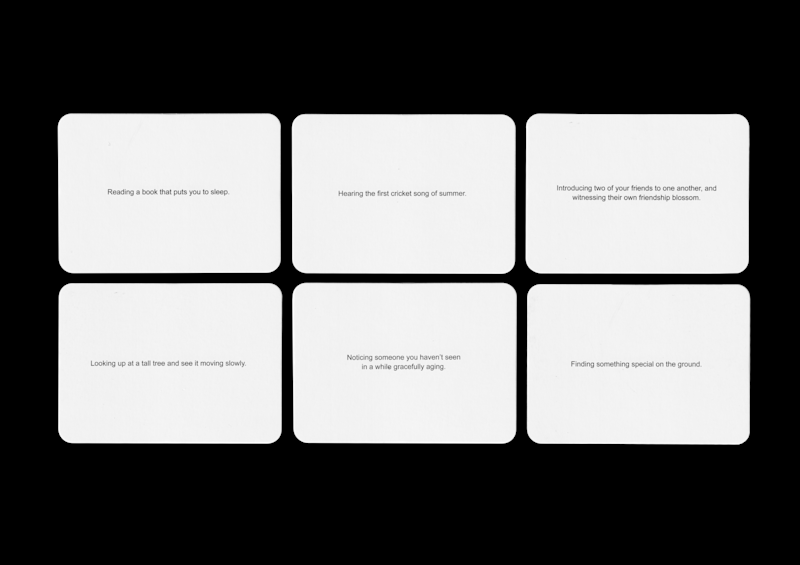
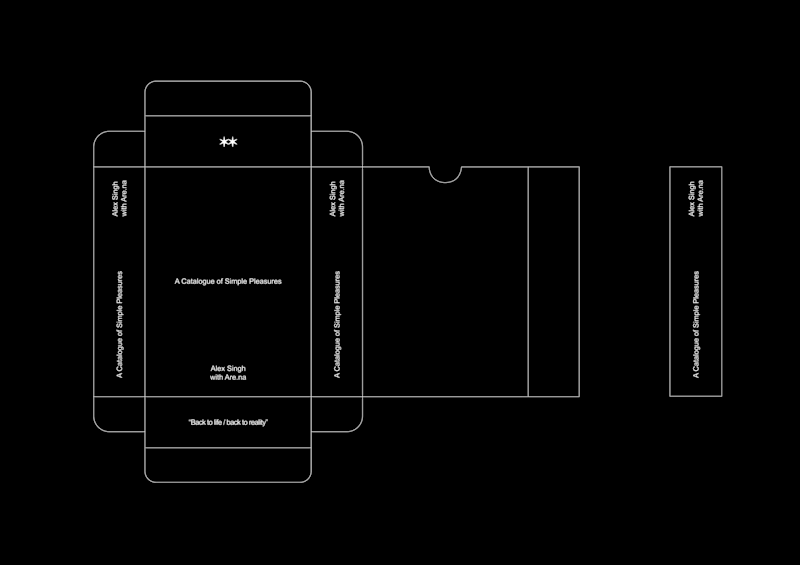
Laurel Schwulst:
You started the channel “A Catalogue of Simple Pleasures” about six years ago now. What do you remember about its beginning?Alex Singh
: I don't remember anything whatsoever. Which I think is a wonderful thing, and at the heart of the project. Let’s start here: The project was never meant to be a project. It just emerged. Likely it came from subconscious remixing and researching I was doing at the time. I was interested in ambient computing and design practices. I was also disenchanted with the state of the internet.
In its six-year lifespan, there has been a substantial amount of time that I didn’t pay much attention to the channel. I just let it do its thing. It existed. People contributed to it.

Cab Broskoski:
I like imagining Alex thinking about what a simple pleasure is. Defining what fits inside the channel is an interesting exercise, since “simple” is relative, and “pleasure” is also relative, you know?What’s interesting is that without much direction from Alex, people felt comfortable jumping in and adding their own simple pleasures. I think it’s because there were many wonderful examples at the beginning. And maybe finding a good simple pleasure is a simple pleasure.
Megan Pai:
Some of them are very personal and intimate. Others are universally appreciated pleasures. It’s cool to experience both ends of that spectrum.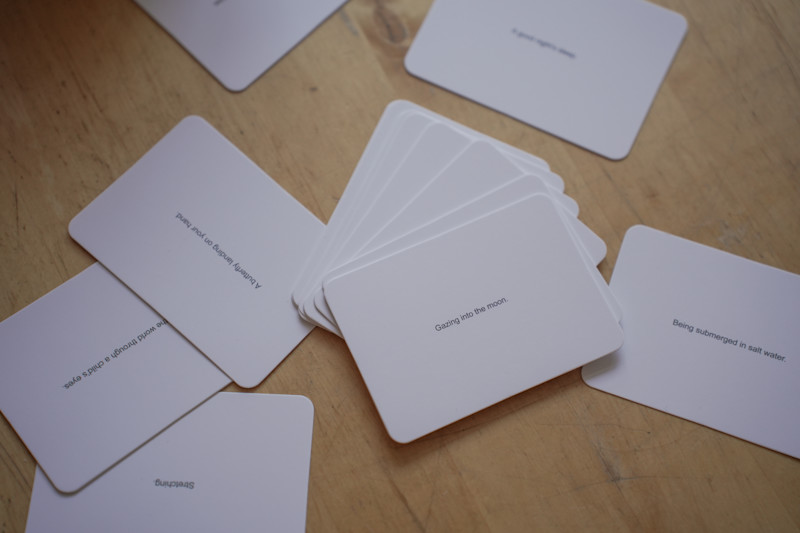
Laurel:
This year, we turned the Are.na channel into a physical publication — a deck of cards. It’s now available as an editioned item in our store.The channel very easefully turned into a deck of cards. There are many reasons for this, but to start, the descriptions of simple pleasures are quite short and monolithic. They look good centered on cards. The project overall has themes of serendipity, openness, and flexibility — the cards format made that more lived. We’re curious to hear how people end up using them…
We view the deck of cards as an “unbound book.” This is partially because Alex reached out to us at the beginning of the year wanting to publish the channel into a book. I was excited by the prospect, but I wasn’t sure about the traditional book format. I suggested cards instead.

Laurel:
Alex, I’m curious. What about the cards format resonated with you?Alex:
It felt like you'd cracked the code. You looked at the channel and its concept, and you could see it fully and completely in its true nature. I got struck almost, you know, like a ping from the universe, as you might say. [Laughs] I thought to myself, “Obviously there's no other way that it could be.” Your suggestion was itself, in some ways, a simple pleasure as well. It was so assuredly correct and right, just perfect and meant to be. It was a very intense feeling.
Laurel:
Wow, I’m honored. Which reminds me that my favorite thing about this project has been its easefulness. In other words, it has felt very natural to make choices. With this project, everything easily comes into being.One of many magical moments happened while I was collecting references for the project. I remembered this deck of cards called Melting Landscape that’s published as an artist book that Megan [Pai] previously gifted me. The deck depicts ideas for structures by a Japanese architect, Kei Kaihoh.
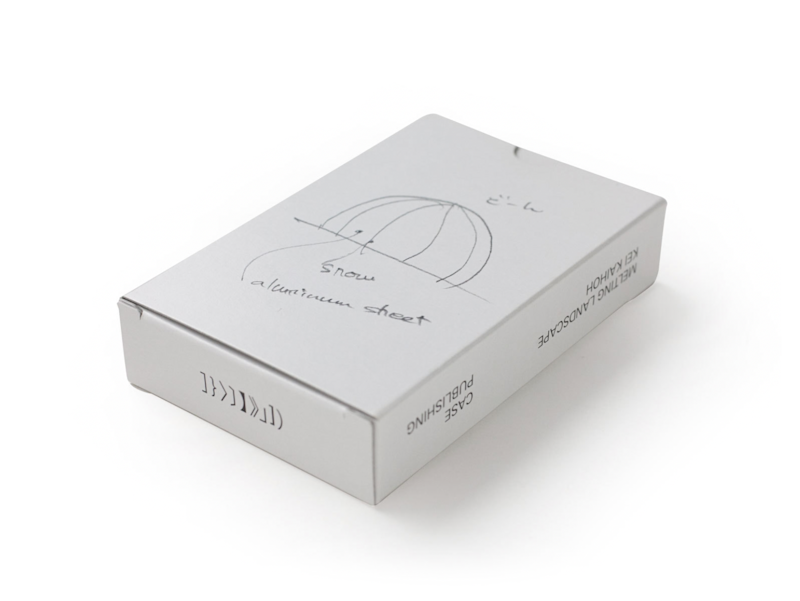
Ever since Megan gifted these cards to me, I’ve wanted to create a publication as a set of cards someday. (I was also inspired by Brian Eno’s Oblique Strategies, which has more formal alignment.) It also felt extremely easeful to commission Megan as a designer to typeset them. Megan gifted me the cards, and this was an item for the Are.na Gift Shop…
Small but significant synchronicities feel like little gifts from the universe. I feel very lucky to have been led by ease. Cab, you said something similar at the beginning regarding this project, “This feels really right to do.”
Cab:
Definitely. The idea and all the serendipity was all a simple pleasure.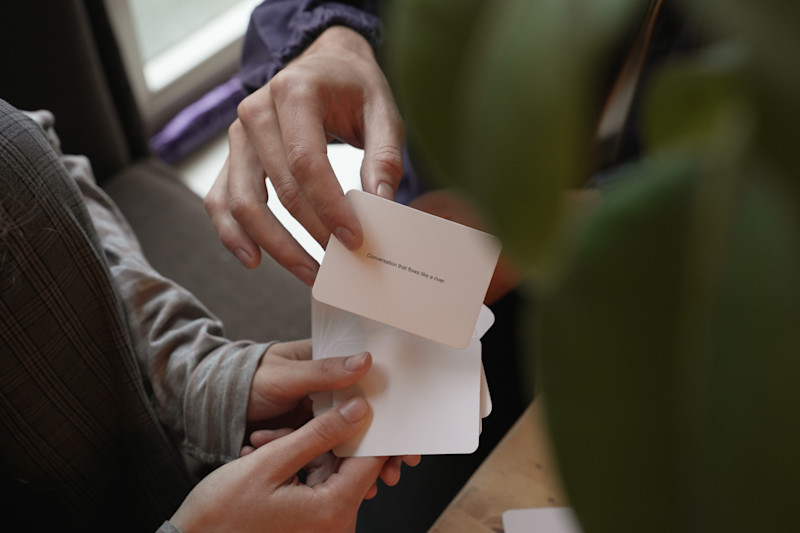
Alex:
This might sound a bit woo, but it was almost like we were being guided by the channel itself. The channel has an easefulness to it. It has its own rhythm. The card format speaks to the conciseness of the simple pleasures themselves and the architecture of Are.na. It’s like a physical mirror to how Are.na works, its “blocks” which can be rearranged and reconfigured. It’s a pleasant framing to think of ourselves as mere vectors. We are helping the project become what it needs to, or doing its bidding. [Laughs] The channel is guiding us in its own becoming.
The channel has its own energy, its own life force. It’s deeply grounding. Creating a physical artifact felt obvious to do. The whole channel feels incredibly and profoundly rooted in physical existence. Maybe its natural form is to be embodied physically.
Megan:
I’ve been thinking about vocabulary in other languages to describe very specific situations, but all within a single term. In a way, making these sentiments physical is like adding them to our vocabulary.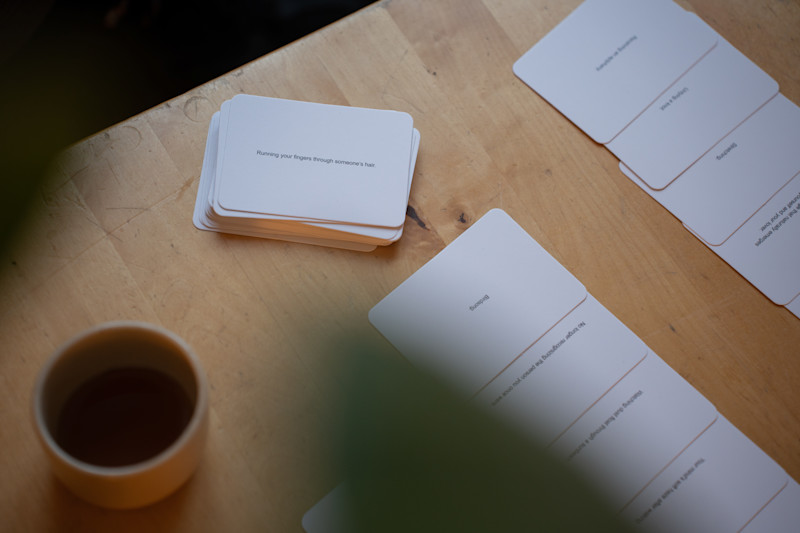
Laurel
: It’s beautiful to designate something a simple pleasure because it’s an act of collective literary expansion. Once it's named, you realize it exists in life. And even if you haven’t done that particular thing before, it’s now something you can access simply because it’s been named by someone else.To paraphrase something Alex said while we were working together: These simple pleasures are all around us. They don’t cost anything. For example, you can blur your eyes. That’s a beautiful thing that’s possible. You simply have to remember. A lot of these can be experienced now in the present moment. If we are able to remember that we can access these experiences, we may be far more nourished in a wholesome, maybe even spiritual, way. We just have to shift our perception.
Cab:
It’s interesting how useful the channel is, too. It's a nice reminder to look at your own life through the lens of, “Everything you need is kind right in front of you.” It’s about perception. Of course, there’s joy to be had all around us. But there’s also a practicality, a function, to being able to look at the world like that. Alex, you’ve been the ambient steward of the channel for a long time. Other people picked up the stewardship sometimes, too. If you look at the channel today, for instance, you can see that leslie liu was really holding it down for a certain period of time.
I’m not sure exactly what I’m trying to say, but I’m picturing a Venn diagram of some sort. The fact that it’s useful to look at the world in this way. The fact that individuals get inspired to add upon that definition. The fact that the channel appears to be sentimental, but that it’s also useful.
Laurel:
Yeah, I see the channel as useful too. It’s similar to how beautiful books or films are useful. It’s a way of seeing the world, a frame…Alex:
The channel is like a prism. That is, if you look at something through a prism, it will change how you see it.The content feels like it can be almost anything. And people can have different interpretations. Someone might experience it and think, “Here are many pleasant experiences people can have.” Or, “This is a nice collection of lived anecdotes.” Or, “This is poetry.” Or, “This is a series of meditations.”
The card format takes that a step further. When we first started talking about the cards, we talked about picking three, four, or five cards each day and laying them out. They could guide your day.
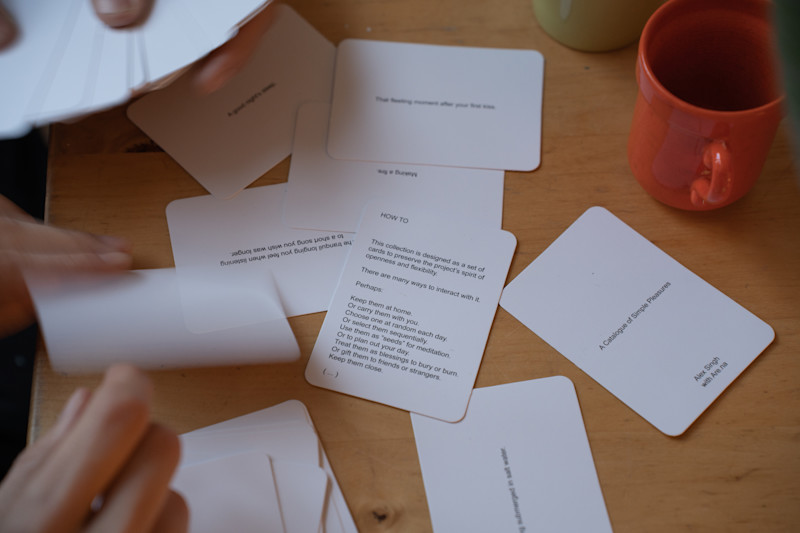
Laurel:
Cards are like Are.na blocks in the physical world. The beauty of cards is that they become a tool. They can be recombined and played with in many different ways, potentially. You could choose one, or a handful, at random each day as a guide. You could use them as seeds for meditation. You could gift them to friends. There are many uses we probably don’t know yet, that can only be understood through use and play… Megan:
The cards remind me of the curation process. When Alex and Laurel were deciding on which of the 400+ simple pleasures from the Are.na channel to turn into the 52 cards — which is the standard amount for playing cards — you came up with two axes you placed the cards on…Laurel:
Right, our curation methodology 2 × 2! Our x axis was about “accessibility” — we wanted a balance between simple pleasures that were possible immediately, right now … and then others that maybe require a certain environment or situation. The y axis was about “poetry” which was a little harder to define, but similarly we wanted a balance between grounded or “earthy” simple pleasures … and then ones that felt a little more dreamy, or “airy.”Megan:
This underlying architecture or logic points to us considering this deck of cards as a cohesive publication itself, like a book. When we were designing it, we considered it an “unbound book.” The card format has a serendipitous quality, which is an overarching theme of the project. They can be randomized by shuffling. You can encounter unexpected combinations of sentiments. These shifting adjacencies can be activated through playing.Speaking of an unbound book, it was especially fun to consider the “tuck box” — which I’ve learned is what the case is technically called. I see this box as the “binding” for this book. We decided the side of the box should function like a book spine. If you put it next to your other books on your bookcase, for instance, it will be legible.
Laurel:
That reminds me. When we were making the final proof to send to the printers, without even trying, we started with the simple pleasure “Making a fire.” And we ended with “Letting the world decide for you.” It serendipitously made sense, like a narrative. It speaks to the strength of the project overall, that somehow that happened to happen.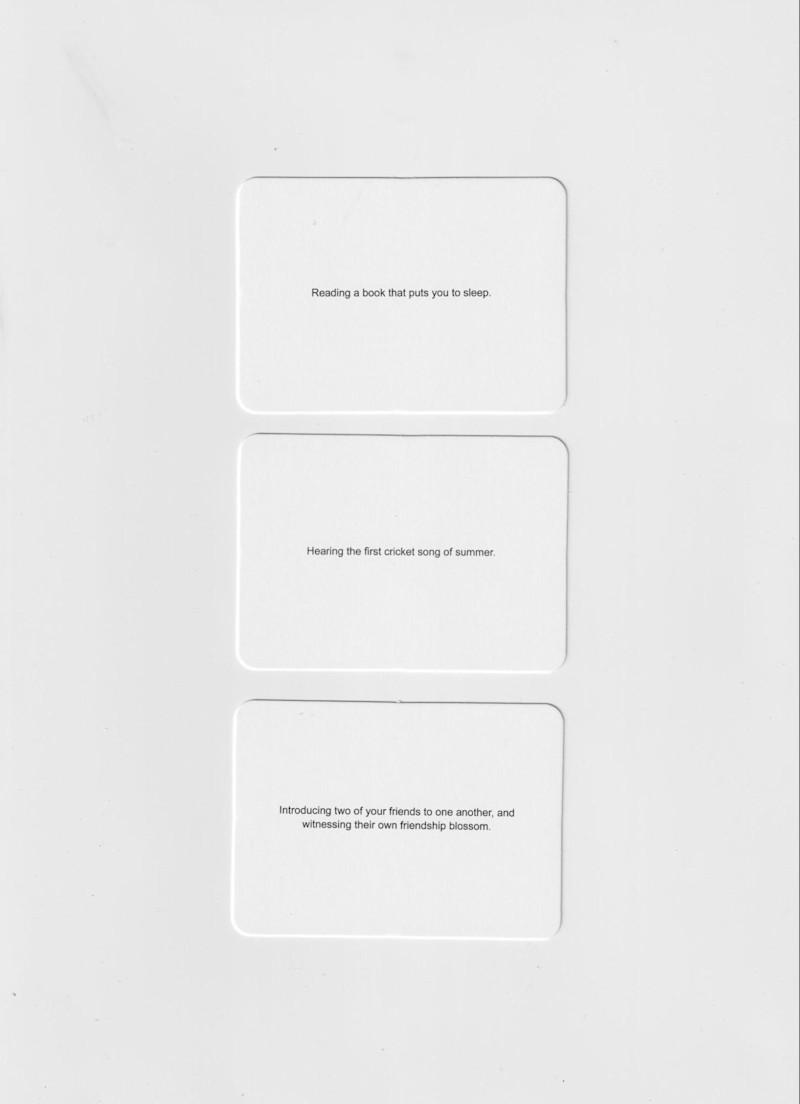
Cab:
Alex, It's interesting you had “no idea what you were doing” when you started the channel. But you made the title, you made the description, and added a few beginning simple pleasures. You made the channel open. Those things allowed others to contribute, which they easily did. You set the stage, and the stage was set correctly.Alex:
The last few years, I've been feeling like an embodied conduit for creativity. I’ve definitely shifted my perspective from this self-centered notion of an individual as a singular source of creative expression. So thank you for saying that.Looking back now at the channel’s slow evolution over the past six years, I realize it’s incarnating itself through us rather than being a distinct creative endeavor created by any single individual.
When I look back at “A Catalogue of Simple Pleasures,” I wonder, how did that even emerge? It feels like a spark. It’s such a poetic, distinctive title. It was reflective of some of the inspiration I was around, like being immersed in Are.na’s culture.
It’s simply something that just needed to come into being, so I started it. At this point, it’s beyond me. Or it’s always been beyond me.
**
There is a vitality, a life force, an energy, a quickening that is translated through you into action, and because there is only one of you in all of time, this expression is unique. And if you block it, it will never exist through any other medium and it will be lost. The world will not have it. It is not your business to determine how good it is nor how valuable nor how it compares with other expressions. It is your business to keep it yours clearly and directly, to keep the channel open. You do not even have to believe in yourself or your work. You have to keep yourself open and aware to the urges that motivate you. Keep the channel open. ... No artist is pleased. [There is] no satisfaction whatever at any time. There is only a queer divine dissatisfaction, a blessed unrest that keeps us marching and makes us more alive than the others. — Martha Graham, Keep the Channel Open
**
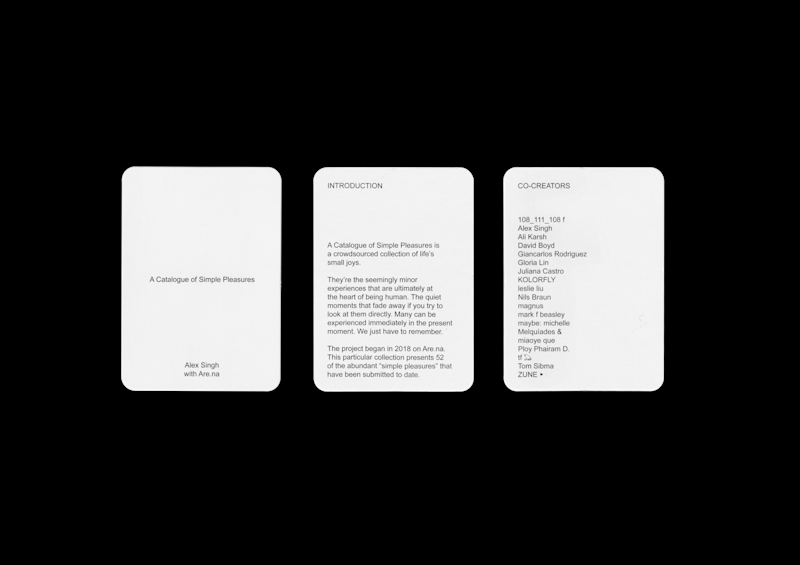
**
Alex Singh’s “A Catalogue of Simple Pleasures” is now available on the Are.na Gift Shop. It’s an “unbound book” — a deck of 55 cards, containing 52 simple pleasures.
Alex Singh is a liminist living in-between.
Laurel Schwulst is imagining & developing the Are.na Gift Shop.
Cab Broskoski is one of the many co-founders of Are.na.
Megan Pai is a designer in discovery mode.
Are.na Blog
Learn about how people use Are.na to do work and pursue personal projects through case studies, interviews, and highlights.
See MoreYou can also get our blog posts via email